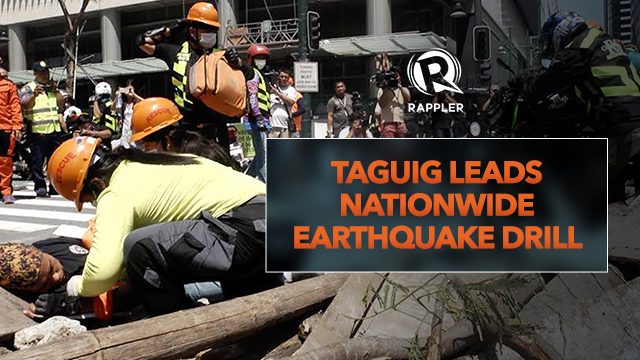SUMMARY
This is AI generated summarization, which may have errors. For context, always refer to the full article.

MANILA, Philippines – Bonifacio Global City (BGC) in Taguig is one of the premier business districts in the Philippines. But is it earthquake ready?
On Thursday, July 23, the city of Taguig served as the main staging area for the nationwide simultaneous earthquake drill. The exercises tested the city’s capability to respond to a possible 7.2-magnitude earthquake that can be caused by the West Valley Fault.
Different cities and provinces across the country also held their own earthquake drills.
David Lozada reports.
Hundreds of Taguig residents evacuate to safety.
The highways are littered with rubble from collapsed infrastructure.
On the streets lie bodies of injured workers from nearby establishments.
This is the scenario expected to happen in Bonifacio Global City one of Metro Manila’s business centers when a 7.2-magnitude earthquake strikes.
Thankfully, this is just a drill.
Taguig serves as the main staging area for the nationwide simultaneous earthquake drill.
The scenario is based on the movement of the West Valley fault which traverses the National Capital Region.
Various studies say Metro Manila is expected to incur heavy infrastructure damage and mass casualties if the West Valley Fault moves.
Taguig’s responders do high angle rescue, medical emergencies, and peace and order exercises to prove their capability.
Philippine disaster management chief Alexander Pama says the drills aim to strengthen communication lines between government agencies and raise awareness on disaster preparedness.
ALEXANDER PAMA, NDRRMC EXECUTIVE DIRECTOR: Kahit buong Metro Manila magre-respond, kung hindi nagkakaintindihan lalo lang magulo. Kaya yung sistema napaka-importante. Kaya natin ginagawa ito para maitulak sa kaalaman ng ating mga kababayan na pag nangyari yan, huwag mag-panic. Meron tayong sistema, makipagugnayan sa mga barangay officials.
(We are doing these drills so we can raise the awareness and knowledge of the public in case this earthquake happens. We want them to not panic, because we have a system, and coordinate with their local officials. Even if the entire Metro Manila responds to such a catastrophe, it will still be chaotic if we don’t understand each other. That’s why the system is very important.)
Various drills are also held in schools and government offices in cities like Makati and Marikina and provinces like Laguna, Sorsogon, Iloilo, and Bukidnon across the country.
Philippine Institute of Volcanology and Seismology Director Renato Solidum says there is no need to fear natural hazards if we are prepared.
DR RENATO SOLIDUM, PHIVOLCS DIRECTOR: Dito po natin pinapakita na ang mga faults ay hindi dapat katakutan, ang lindol ay hindi dapat katakutan kung ito ay mauunawaan natin ano mga panganib na dulot nito. Magiging kalmado tayo kung tayo ay naghahanda at alam na natin ang paghahanda kung ano dapat gawin
(We want to show people that we should not be afraid of fault lines and earthquakes if we study the dangers they pose. We should be calm if we are prepared and we know what to do.)
The nationwide earthquake drill comes a week before the first Metro Manila wide quake drill set for July 30.
It will follow the same West Valley Fault scenario.
The nationwide earthquake drill gives the public an important message – though different government units have the capacity to respond to major disasters, it is our readiness that will define our resiliency. When an earthquake strikes, our preparedness will be key to our survival. – Rappler.com
Add a comment
How does this make you feel?
There are no comments yet. Add your comment to start the conversation.